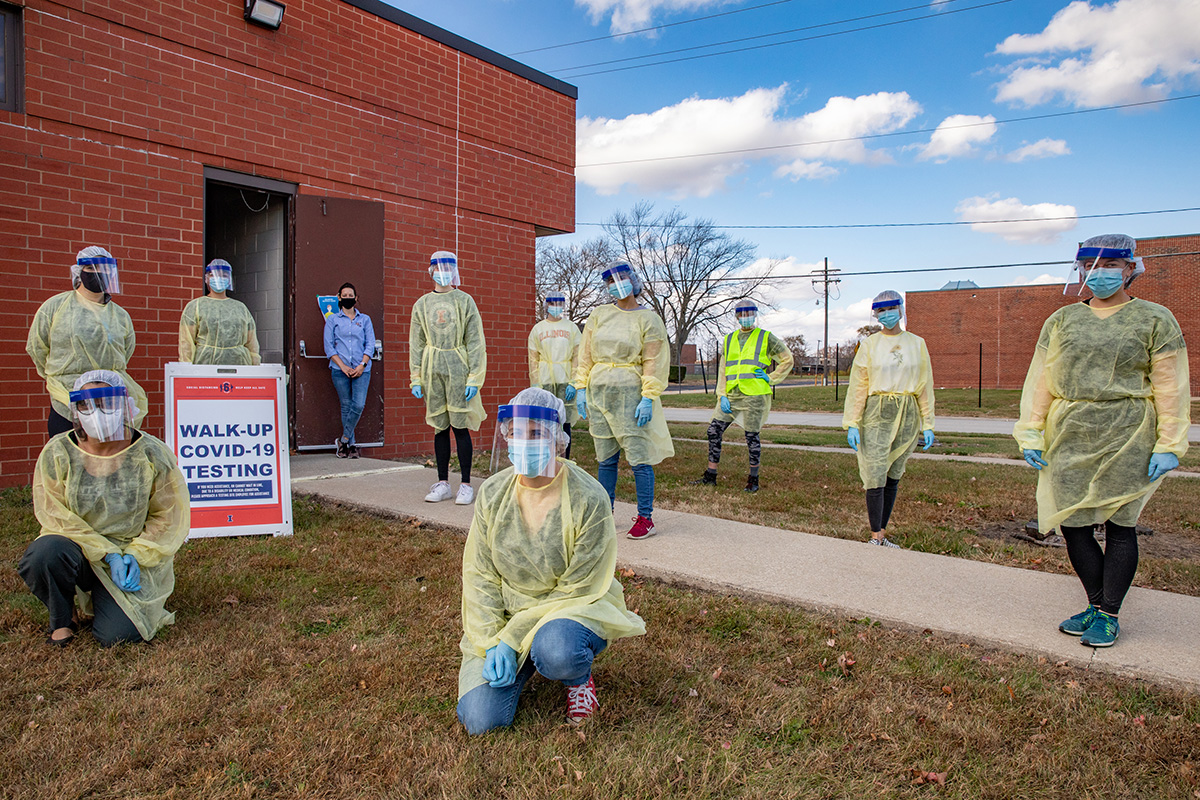Initiative offers COVID-19 testing, explores virus transmission's social factors
An interdisciplinary team of Illinois scientists is working with clinicians and community researchers to expand access to COVID-19 testing by providing pop-up testing clinics for agricultural workers and others at various locations in Rantoul, Illinois.

The team – microbiology professor Rachel Whitaker (IGOH leader/BCXT) and anthropology professors Jessica F. Brinkworth (IGOH), Korinta Maldonado, Ellen Moodie and Gilberto Rosas – also is investigating the structural, economic and sociocultural factors that impact transmission and response to the disease among essential agricultural laborers in rural communities like Rantoul.
Workers at the Rantoul Foods pork-processing plant were among the first outbreak clusters when COVID-19 emerged in central Illinois early last spring. When that cluster occurred, a group of researchers at the IGB assembled to see whether experts at the university could help contain the spread.
James F. Lowe (IGOH), a professor of veterinary clinical medicine, and civil and environmental engineering professor Helen Nguyen (IGOH) collected 24 air samples and 140 surface samples in the plant over a seven-week period. But when they found no traces of the virus in those samples, it raised questions about how the disease was being spread person to person at work and among other people in the community.
“Efforts to find out how the disease spreads within this community are pivotal,” said Lowe, a leading researcher on disease control and biosecurity in the meat industry. “These essential workers are valued and protected in the workplace. When they are unable to do their jobs, the entire food production pipeline, from farm to table, is disrupted.”
“The problem is, in this community and others there are many essential workers but not universal access to COVID-19 testing resources or response,” Whitaker said. “There’s generally not a lot of infrastructure for reaching these groups.
“The Labor Health Equity Action Project started out with this acute realization of an infection cluster, and then quickly turned to all of these complexities that might cause people, especially essential workers, to be more susceptible to or affected by the COVID pandemic. This is a really important area of research that’s growing.”
According to data from the U.S. Centers for Disease Control and Prevention, front-line and essential workers are at increased risk of exposure to COVID-19. Moreover, many of these workers are racial and ethnic minorities, who are more likely to progress to severe cases.
“Rantoul has a very diverse community and its industries recruit worldwide – in Africa and Central America as well as Puerto Rico – so they have workers who speak Spanish, Lingala, the Mayan language Q’anjob’al and other languages,” said Rosas, who is a professor of Latina/o studies and an expert on migration and violence along the U.S.-Mexico border.
Dr. Cristina Medrano, who is employed pat-time at the U. of I.’s McKinley Health Center and is establishing a private practice in Champaign, organized volunteer clinicians for the project. They and the U. of I. team have coordinated four testing clinics so far, including one at Rantoul’s Multicultural Community Center that was provided in conjunction with Frances Nelson Health Center. Other clinics were held at the Greater New Light Baptist Church and at Rantoul Parks and Recreation Department facilities.
Participants are donating blood and saliva samples for testing, and they are being surveyed about behaviors and about living and working conditions associated with higher rates of infectious disease.
The research may shed light on disparities in COVID-19 infection rates among various demographic groups, Brinkworth said.
In addition to organizing the clinics, Brinkworth is researching the roles of social stress and life experiences on immune function and COVID-19 transmission and severity among Rantoul workers.
“We also want them to tell us what misinformation they may have received and what their needs are – all of that affects where we go and what we try to do next,” she said. “The circumstances here in Rantoul reiterate what’s happening all across the Midwest and globally.”
“Obviously, testing is not the only answer and is one element of a larger strategy,” said Moodie, who is an expert on Central America, human rights and ethnographic research. “Our goal is to understand how we can address questions of how to protect oneself, what are good public health practices and how to mitigate the spread of the virus within particular communities.”
Three community researchers hired and trained by the anthropologists are conducting ethnographic interviews by phone, collecting data on the social pathways that promote transmission of the disease. These researchers either have experience working with agricultural workers or are of races or ethnicities represented in the broader community.
“These groups deserve not only equal access to testing and health care but also to knowledge about virus transmission,” said Maldonado, who also is a professor of American Indian studies. “By producing the research knowledge collaboratively and reporting the findings back to these communities, we can find better, smarter mitigation strategies.”
Funding for the project was provided by the College of Agricultural, Consumer and Environmental Sciences; the Office of the Vice Chancellor for Research and Innovation; the IGB; the Illinois Pork Producers Association; and private donors.
